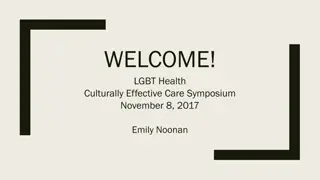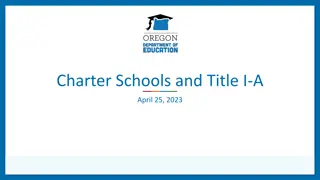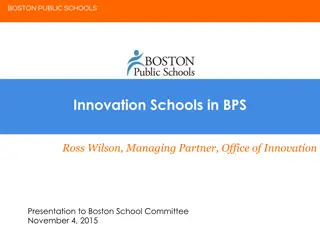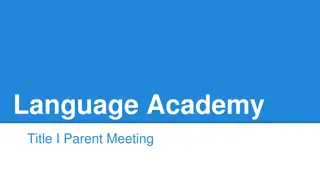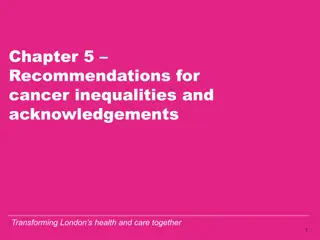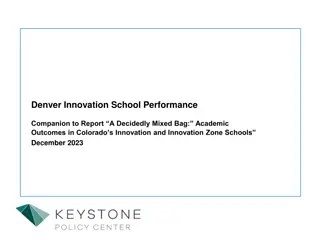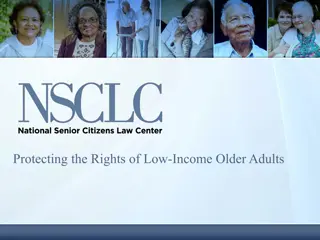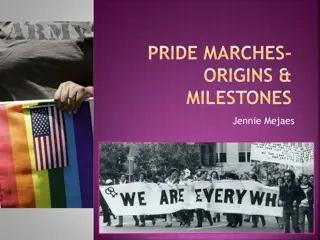LGBT Issues in Schools
Definitions of key terms related to LGBT issues in schools are provided, including terms like transgender, queer, gender non-conforming, cisgender, asexual, intersex, and ally. These definitions help in promoting inclusivity and understanding among students, educators, and staff members in school environments.
Download Presentation

Please find below an Image/Link to download the presentation.
The content on the website is provided AS IS for your information and personal use only. It may not be sold, licensed, or shared on other websites without obtaining consent from the author. Download presentation by click this link. If you encounter any issues during the download, it is possible that the publisher has removed the file from their server.
E N D
Presentation Transcript
LGBT ISSUES FOR SCHOOLS Jollee Patterson General Counsel, Portland Public Schools December 2015
DEFINITIONS LGBT, LGBTQ, LGBTQA, TBLG LGBT, LGBTQ, LGBTQA, TBLG: These acronyms refer to Lesbian, Gay, Bisexual, Transgender, Queer or Questioning, and Asexual or Ally. Biological sex at birth Biological sex at birth: : The objectively measurable organs, hormones and chromosomes a person possesses at birth associated with males, females or intersex people. Gender identity Gender identity: : How people think of themselves and which gender they feel they are. Gender identity is an emotional, rather than a physical, characteristic. Gender expression Gender expression: : How people demonstrate their gender to the outside world through dress, speech, behavior, etc.
DEFINITIONS Transgender Transgender: An umbrella term for people whose gender identity and/or gender expression differs from what is typically associated with the sex they were assigned at birth. Transgender female Transgender female: : This is a person whose assigned sex at birth is male but identifies and lives as a female. Transgender male Transgender male: : This is a person whose assigned sex at birth is female but identifies and as lives as a male. Queer Queer: : An umbrella term for LGBT people, which was historically derogatory but has been reclaimed by people wishing to self-identify as queer.
DEFINITIONS Gender Non Gender Non- -Conforming expression is different from conventional expectations of masculinity and femininity. Not all gender non-conforming people identify as transgender, nor are all transgender people gender non-conforming. Gender Fluid Gender Fluid: : A gender identity that varies over time. A gender fluid person may at any time identify as male, female, or another non-binary identity, or some combination of identities. Cisgender Cisgender: : People who are not transgender. In other words, their gender identity is the same as the sex they were assigned at birth. Conforming: People whose gender
DEFINITIONS Gender Gender- -neutral either female or male. Asexual Asexual: : A person who generally does not feel sexual attraction or desire to any group of people. Asexuality is not the same as celibacy. Intersex Intersex: A general term used for a variety of conditions in which a person is born with reproductive or sexual anatomy that doesn t fit the typical standard of female or male. Ally Ally: Typically any non-LGBT person who supports and stands up for the rights of LGBT people, though LGBT people can be allies, such as a lesbian who is an ally to a transgender person. neutral: This is a person who does not identify as
DEFINITIONS Transition Transition: The process by which a person begins to live as the gender with which they identify, rather than the gender they were assigned at birth. It is not a one-step procedure, but rather a complex process that occurs over a period of time. Transition includes some or all of the following steps: telling one's family, friends, and co-workers; using a different name and new pronouns; dressing differently; changing one's name and/or sex on legal documents; hormone therapy; and possibly (though not always) one or more types of surgery. The exact steps involved in transition vary from person to person.
OREGON EQUALITY ACT The Oregon Equality Act of 2007 amended many statutes to prohibit discrimination on the basis of sexual orientation. ORS 174.100: Sexual orientation means an individual s actual or perceived heterosexuality, homosexuality, bisexuality or gender identity, regardless of whether the individual s gender identity, appearance, expression or behavior differs from that traditionally associated with the individual s sex at birth. The Act forbids discrimination based on sexual orientation in employment, housing, public accommodations, public meetings, public services, public education, adult foster homes, and foster parenting.
OREGON LAW - PROHIBITION OF DISCRIMINATION IN EDUCATION ORS 659.850 provides: (1) As used in this section, discrimination means any act that unreasonably differentiates treatment, intended or unintended, or any act that is fair in form but discriminatory in operation, either of which is based on race, color, religion, sex, sexual orientation, national origin, marital status, age or disability. (2) A person may not be subjected to discrimination in any public elementary, secondary or community college education program or service, school or interschool activity or in any higher education program or service, school or interschool activity where the program, service, school or activity is financed in whole or in part by moneys appropriated by the Legislative Assembly.
FEDERAL LAW -- TITLE IX No person in the United States shall, on the basis of sex, be excluded from participation in, be denied the benefits of, or be subjected to discrimination under any education program or activity receiving Federal financial assistance. 34 C.F.R. 106
OFFICE OF CIVIL RIGHTS -- GUIDANCE RE LGBT STUDENTS Bullying and harassment based on actual or perceived sexual orientation or gender identity must be taken seriously. Schools must promptly investigate and take action if warranted. Questions and Answers on Title IX and Sexual Violence 2014 http://www2.ed.gov/about/offices/list/ocr/docs/qa-201404-title-ix.pdf Bullying and Harassment 2010 http://www2.ed.gov/about/offices/list/ocr/letters/colleague-201010.pdf OCR requires training for staff regarding LGBT students: Thus, a school should ensure that its counselors and other staff who are responsible for receiving and responding to complaints of sexual violence, including investigators and hearing board members, receive appropriate training about working with LGBT and gender-nonconforming students and same-sex sexual violence.
OCR GUIDANCE RE LGBT STUDENTS Under the Equal Access Act, schools must allow a Gay Straight Alliance and other similar clubs if the school allows any student-initiated clubs. http://www2.ed.gov/policy/elsec/guid/secletter/110607.html Department of Education asks questions about bullying based on LGBT status in the Office of Civil Rights Data Collection. http://ocrdata.ed.gov/
OCR: TITLE IX COVERS GENDER IDENTITY Title IX s sex discrimination prohibition extends to claims of discrimination based on gender identity or failure to conform to stereotypical notions of masculinity or femininity and OCR accepts such complaints for investigation. Similarly, the actual or perceived sexual orientation or gender identity of the parties does not change a school s obligations. Questions and Answers on Title IX and Sexual Violence 2014 OCR Training Tool: Title IX: Addressing Harassment and Different Treatment on the Basis of Gender Identity and Gender Nonconformance. http://www.ode.state.or.us/policy/federal/civilrights/3.2015-gender- identity-gender-nonconformance-presentation.pdf
OCR ENFORCEMENT AND REMEDIES An OCR complaint filed against a school district may result in remedies and enforcement. OCR Resolution Agreements can include: specific access and plan for the individual student, policy/procedure revisions, engaging consultants with expertise in gender identity, providing access to specific facilities at all schools and district-sponsored activities (including off-campus), establishing support teams for students, education and training for all staff, curriculum and instruction, and school-climate assessments. Example: Resolution Agreement, Downey Unified School District, OCR Case No. 09-12-1095, Oct. 8, 2014; http://www2.ed.gov/documents/press- releases/downey-school-district-agreement.pdf
TITLE IX - OFFICE OF CIVIL RIGHTS Palatine-Schaumburg High School District 211 is defying an OCR order to allow a female transgender student access to the girls locker room under the same terms and conditions as other girls. If the school district continues to deny access, it risks losing $6 million in federal funding. On November 2, 2105, OCR sent a letter of 30 day notice for the issuance of a Letter of Impending Enforcement Action. https://assets.documentcloud.org/documents/2501220/letter-from-the-u- s-dept-of-education-to-daniel.pdf OCR letter goes into great detail about the restroom and changing areas. The district provided significant access for the student. The dispute appears to be about whether the school can require the transgender student to change behind a privacy curtain and whether sufficient privacy curtains are provided for all students to use if desired. OCR position is that transgender students should have full access to sex-specific locker rooms.
TITLE IX FEDERAL LAW Grimm v. Gloucester County School Board, __ F. Supp. 3d. __, 2015 WL 5560190 (E.D. Va. 2015). School district policy prohibiting transgender students from using the bathroom of their identified gender did not violate Title IX. Court found that federal regulations under Title IX allow schools to maintain separate bathrooms for each sex, so the School Board did not run afoul of Title IX by limiting G.G. to the bathroom assigned to his birth sex. Rejected OCR s Guidance on the application of Title IX to transgender students. Case is currently on appeal to 4thCircuit.
OREGON DEPARTMENT OF EDUCATION The mission of ODE is to foster excellence for every learner through innovation, collaboration, leadership and service to our education partners. As an organization, we value equity for every student. For students to be successful in their academic lives, they must be safe in their school environment. Beginning in 2007, Oregon law prohibits discrimination based on sexual orientation which in Oregon includes gender identity. Not all states have protections based on gender identity. (Memo from ODE Support Services Unit, June26, 2014)
POLICIES ARE KEY! Strong Anti Strong Anti- -Harassment Policies Harassment Policies Policies are a public statement of the commitment to student safety and support. See ORS 339.356. Anti-harassment policies protect all students, but schools may need explicit guidance on safeguarding LGBT students including: Prohibiting harassment based on gender nonconformity, identity and expression Communicating effectively and often with students, parents and community about school climate expectations and issues Clearly identifying to whom complaints can be made Establishing procedures for investigation and follow up Keeping students safe pending the outcome of the investigation
TRANSGENDER STUDENTS HOW TO WE KNOW? Palatine-Schaumburg High School District policy provides that a transgender student is a student who consistently and uniformly asserts a gender identity different from the student s assigned sex, or for which there is documented legal or medical evidence that the gender identity is sincerely held as part of the student s core identity. In case establishing rights of transgender students, Maine Supreme Court warned that the decision must not be read to require schools to permit students casual access to any bathroom of their choice. Consult with student, family if appropriate, counselor. Very uncommon for students to fake transgender status.
TRANSGENDER STUDENTS RESTROOMS/LOCKER ROOMS No Oregon case directly on point for transgender students in public k-12 schools, but ORS 659.850, federal court interpretation of Title IX, OCR Guidance and ODE statements will be significant considerations. PPS allows transgender students to use the facilities of their identified gender. No significant issues with this policy. PPS is also creating single stall, unisex bathrooms in high schools. Work with student, family if appropriate, staff, facilities department, student leadership, etc. to determine alternatives. Inform community in a positive manner, while protecting student privacy. Distinguish real problems from fear and rumor. Bring in outside expertise to assist in constructive dialogue.
TRANSGENDER STUDENTS SPORTS OSAA uses the same criteria as the National Collegiate Athletic Association. Takes into consideration: (1) the biological sex of the student and (2) status of hormone treatment. Female-to-male transgender with no hormone treatment: Can play on boys or girls team. Once the transgender student selects the team, must consistently participate on teams of that gender. Female-to male transgender with hormone treatment: May participate only on a boys team. Male to female transgender with no hormone treatment: May participate only on a boys team. Male to female transgender with hormone treatment: May participate on a boys team at any time, but must complete one year of hormone treatment before competing on a girls team. http://www.osaa.org/governance/handbooks/osaa#_Toc4260 97038
TRANSGENDER STUDENTS OFFICIAL SCHOOL RECORDS Being able to alter their records and documents is personally and legally important for many transgender students. Not only does having the appropriate name and gender listed reflect and validate their identity, but it can also allow them to avoid constantly having to explain why they use a name different from their birth name and why their appearance does not match a photo or gender designation on an identification card or other record. Moreover, updated records and documents can ensure that transgender students will not be outed and will help protect them from discrimination when they apply for jobs and seek admission to college. (Memo from ODE Support Services Unit, July 26, 2014) https://district.ode.state.or.us/wma/groups/dcc/2014- 15/transgender-student-name-and-gender-change-process.pdf
GENDER & FIRST NAME CHANGE PROCESS Gender change process: ODE will change a student s gender upon request from a district. There is no need for a student to prove their new gender. The student s declaration of their gender is acceptable. (emphasis added) First name change process: While in general, ODE maintains the expectation that legal name in the school record be consistent with the legal name of the student, in the case of transgender students it may be necessary to deviate from this policy to support and protect the student from being inadvertently outed and potentially exposed to bullying and harassment. The student may replace their legal first name with their preferred first name, and retain the same SSID.
TRANSGENDER STUDENTS BULLYING AND HARASSMENT OCR very clear that school districts have an obligation to prevent bullying and harassment on the basis of gender identity. Harassment based on sex, gender or gender identity is a form of discrimination that violates students civil rights. It can deny equal educational opportunities to the harassed student. It can create a hostile environment that undermines the education of all students. Indeed, lesbian, gay, bisexual, and transgender (LGBT) youth report high rates of sexual harassment and sexual violence. A school should investigate and resolve allegations of sexual violence regarding LGBT students using the same procedures and standards that it uses in all complaints involving sexual violence.
TRANSGENDER STUDENTS DRESS CODES Dress codes should not treat transgender students differently. Doe v. Yunits, 2000 WL 33262199 (Mass. Super. Oct. 11, 2000), transgender female student told that she could not attend school wearing disruptive outfits including padded bras, dresses and wigs. Court found student s dress was protected speech. Plaintiff in this case is likely to establish that, by dressing in clothing and accessories traditionally associated with the female gender, she is expressing her identification with that gender. In addition, plaintiff's ability to express herself and her gender identity through dress is important to her health and well-being. Court rejected the argument that the clothing was distracting to the educational environment: Defendants do not find plaintiff's clothing distracting per se, but, essentially, distracting simply because plaintiff is a biological male.
TRANSGENDER STUDENTS OVERNIGHT FIELD TRIPS Under OCR interpretation and growing trend, transgender students should not be treated differently based on their transgender status and should be allowed to access the accommodations of their identified gender. Work closely with student, family if appropriate, and chaperones to determine the right option. PPS generally allows students to stay with students of their identified gender, but takes steps to protect safety and privacy of all students.
GENDER FLUID/GENDER NEUTRAL STUDENTS Developing area of law and policy Very little precedent, but quickly growing. Unisex bathrooms are a key resource for these students. PPS works on a case-by-case basis with students, families and staff in determining how to support students so they feel safe and accepted at school. Students have drastically reduced opportunities for success in school if they are not safe and supported.
CONFIDENTIALITY All students have a right to privacy under FERPA. Schools must be careful to safeguard confidential student information. Education efforts must not focus on particular students. Some families and students want to openly share information with classmates. Obtain a written release from parents, and be clear in advance about what information will be shared. Some student may not want their parents to know about their transgender status. These situations require careful consideration of all the factors, including student safety, age of the student and the nature of the student concerns. Staff should work closely with the student, administration and legal counsel in navigating these situations.
RESOURCES TransActive is a leading organization serving the needs of transgender and gender variant children. TransActive has a local chapter. http://www.transactiveonline.org/index.php GLSEN (The Gay, Lesbian, Straight Education Network) is a prominent organization supporting GLBT youth. They have resources about creating safe and supportive environments for students. http://www.glsen.org/cgibin/iowa/all/about/index.html Oregon Safe Schools and Communities Coalition provide supports for transgender students, and their families and schools. The Oregon Safe Schools and Communities Coalition Resource Manual can be found here: http://www.oregonsafeschools.org/documents/Resource_Manual.pd f The Trevor Project is the leading national organization focused on crisis and suicide prevention efforts among lesbian, gay, bisexual, transgender and questioning youth. http://www.thetrevorproject.org/ PPS Legal Issue Memo: http://www.pps.k12.or.us/files/general- counsel/Transgender_Students.pdf
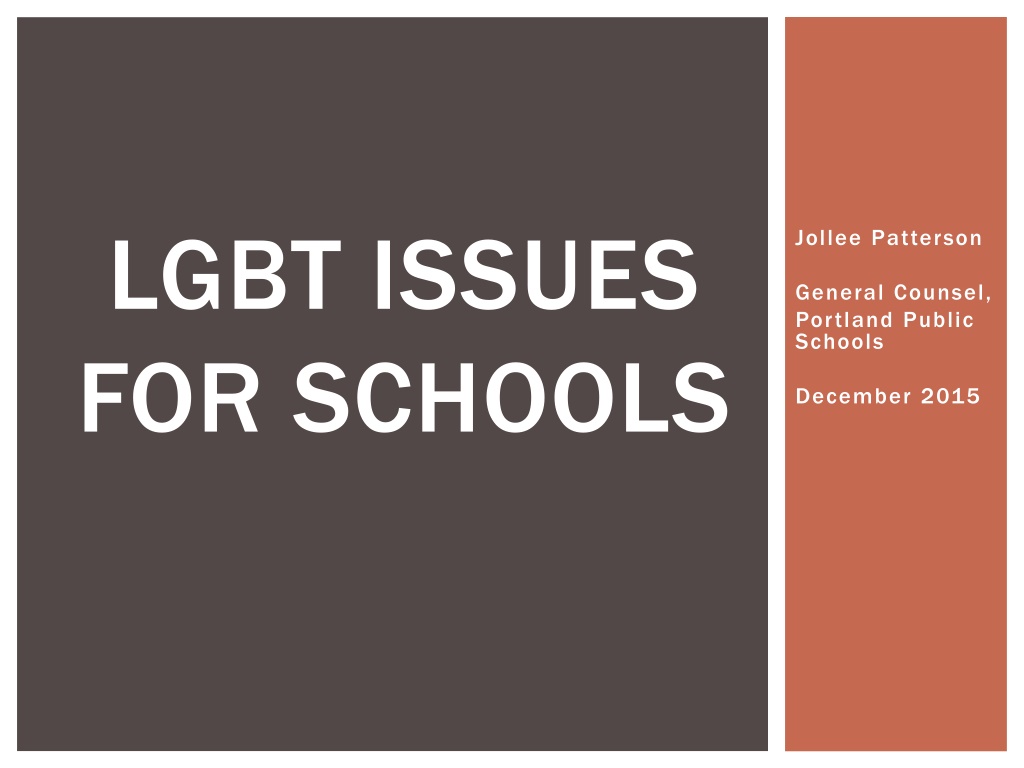
 undefined
undefined









